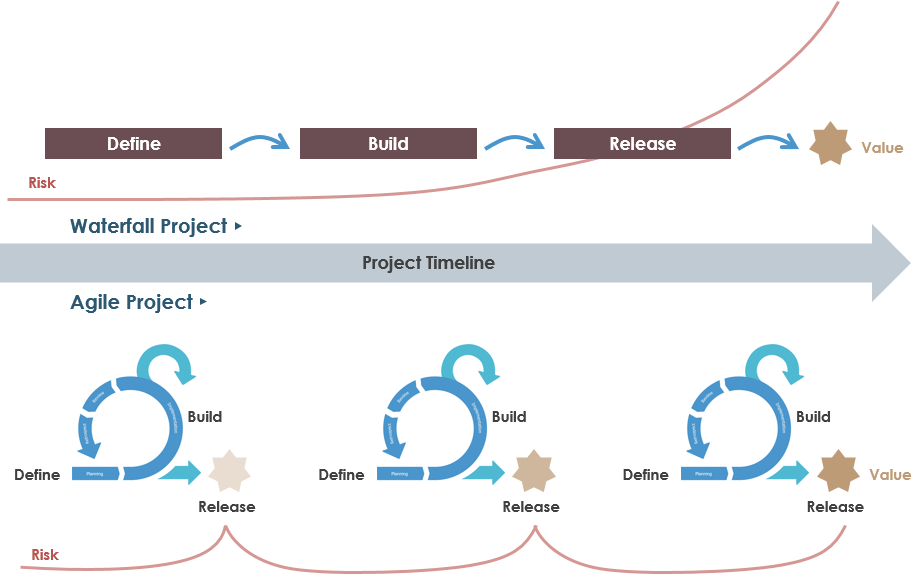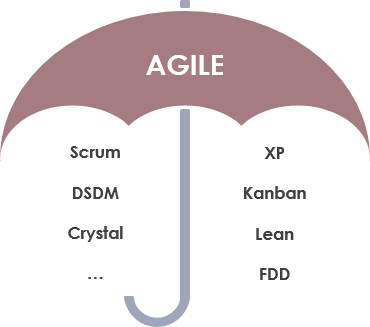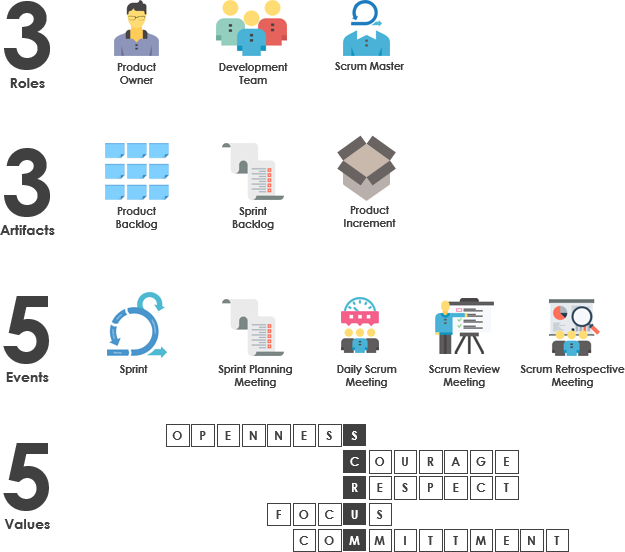There is this perception that Agile applies only in software development. However, times are changing, and we are seeing more and more applications of Agile in broader product development and even in the sales and marketing departments. The core principles of Agile that we see in software development now translate very well to product development.
Agile is a term used to describe approaches to software development emphasizing incremental delivery, team collaboration, continual planning, and continual learning, instead of trying to deliver it all at once near the end.
Agile focuses on keeping the process lean and creating minimum viable products (MVPs) that go through several iterations before anything is final. Feedback is gathered and implemented continually and in all, it is a much more dynamic process where everyone is working together towards one goal.

Agile is a mindset and it’s a set of values and principles. Agile is a way of thinking and acting. Agile is all about short cycles, iterative and incremental delivery, failing fast, getting feedback, delivering business value to customers early and about people, collaboration and interaction. Agile is a mindset that is all about transparency, inspection, and adaptation. Agile, however, doesn’t consist of any roles, events or artifacts. It’s a mindset. For example, Scrum is one of the widely used frameworks under the Agile umbrella, which may help you in becoming more Agile, there are however many more frameworks within the Agile movement, like Kanban, XP, Crystal and many more as shown in the Figure below:

Scrum is a framework within which people can address complex adaptive problems, while productively and creatively delivering products of the highest possible value. It is used for managing software projects and product or application development. Its focus is on an adaptive product development strategy where a cross-functional team works as a unit to reach a common goal within 2-4 weeks (Sprint).
Scrum is a framework for developing and maintaining complex products through “view-and-tune”. It is a genre that follows the agile declaration and principles, integrating three roles, three artifacts, five events, five values, referred to as “3355“.


This is a step-by-step agile scrum tutorial that helps you understand the core concept of agile development as well as the way how agile project can be executed from the beginning until the end (i.e. product delivery). The agile software Scrum Process Canvas will be used throughout this tutorial. The whole agile scrum tutorial will cover various agile topics and it is recommended that readers read this scrum tutorial to fully understand the flow of agile project development.
There is a total of twenty lessons covered in this agile tutorial. Click on a lecture to begin.
s
| Lesson No. | Title | What You’ll Learn |
|---|---|---|
| Lesson 01 | How to Identify Project Vision | Identify project vision Develop Agile Project Charter |
| Lesson 02 | How to Appoint a Product Owner | Appoint a product owner Detail product owner responsibility |
| Lesson 03 | How to Appoint Scrum Master | Appoint scrum master Detail scrum master responsibility |
| Lesson 04 | How to Form a Scrum Team | Select scrum team members Detail scrum team members’ responsibilities |
| Lesson 05 | How to Identify Scrum Project Stakeholders | List scrum project stakeholders Describe the stakeholders |
| Lesson 06 | How to Identify Business Goals | Draw use case diagram Describe use cases |
| Lesson 07 | How to Manage Epics | Create epics in a user story map Describe epics |
| Lesson 08 | How to Manage Product Backlog | Describe scrum project done criteria Create user stories in a story map Define acceptance criteria Prioritize user stories |
| Lesson 09 | How to Develop Release Plan | Identify and describe project deliverables List project releases Re-arrange user stories into releases |
| Lesson 10 | How to Create a Sprint | Create a sprint Configure sprint |
| Lesson 11 | How to Conduct a Sprint Planning Meeting | Select user stories for sprint backlog Identify effort-estimated tasks Identify sprint deliverables |
| Lesson 12 | How to Record Impediment | Log impediment Detail impediment |
| Lesson 13 | How to Create a Burndown Chart | Understand burndown chart Open burndown chart |
| Lesson 14 | How to Create a Scrum Board | Understand scrum board Open scrum board |
| Lesson 15 | How to Conduct Daily Scrum | Record progress of work Conduct daily scrum Record follow-up activities |
| Lesson 16 | How to Conduct Sprint Review | Demonstrate user stories Perform user story acceptance Update progress of project deliverables |
| Lesson 17 | How to Conduct Sprint Retrospective | Record start, continue and stop items Vote and record the result of voting |
| Lesson 18 | How to Conduct Project Retrospective | Document lessons learned – project successes Document project challenges |
| Lesson 19 | How to Generate Report for Scrum Project | Open an auto-generated report Manual report generation |
| Lesson 20 | How to Use Artifact Shortcut | Open artifact via shortcut |
| About Visual Paradigm |
 Visual Paradigm helps organizations stay competitive and responsive to change faster and better in today’s fast-changing environment. Our award-winning products are trusted by over 320,000 users in companies ranging from small businesses, consultants, to blue-chip organizations, universities, and government units across the globe. It enables organizations to improve business and IT agility and foster innovation through popular open standards and process frameworks. Visual Paradigm, a killer Agile feature in 2018, introduced Scrum Process Canvas for automating the way a Scrum team to create, manage and deploy software application that empowers the team to continuously improve their performance at unprecedented speed and scale. Manage the Entire Scrum Process in One Page Automate the Scrum Framework in a fun and enjoyable dashboard with eye-catching updated status. Manage Backlog, Multiple Sprints of different Scrum Roles with a single-page visually executable canvas Allow instant access, review and generate scrum artifacts and related documents to be archived in the Shared Cabinet Automate the Scrum events and related activities with self-explanatory instructions, samples, and required document templates. Visual Paradigm helps organizations stay competitive and responsive to change faster and better in today’s fast-changing environment. Our award-winning products are trusted by over 320,000 users in companies ranging from small businesses, consultants, to blue-chip organizations, universities, and government units across the globe. It enables organizations to improve business and IT agility and foster innovation through popular open standards and process frameworks. Visual Paradigm, a killer Agile feature in 2018, introduced Scrum Process Canvas for automating the way a Scrum team to create, manage and deploy software application that empowers the team to continuously improve their performance at unprecedented speed and scale. Manage the Entire Scrum Process in One Page Automate the Scrum Framework in a fun and enjoyable dashboard with eye-catching updated status. Manage Backlog, Multiple Sprints of different Scrum Roles with a single-page visually executable canvas Allow instant access, review and generate scrum artifacts and related documents to be archived in the Shared Cabinet Automate the Scrum events and related activities with self-explanatory instructions, samples, and required document templates. |